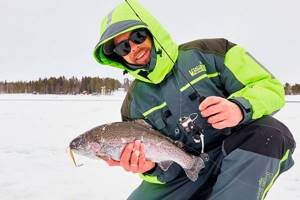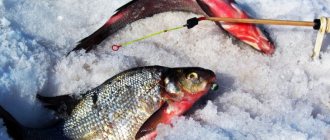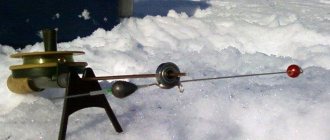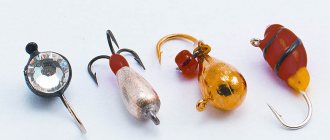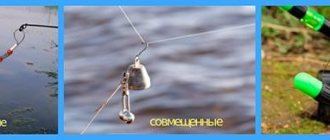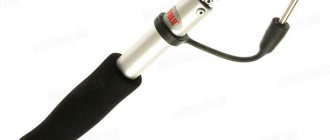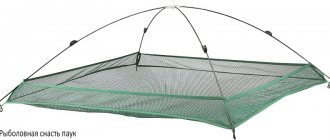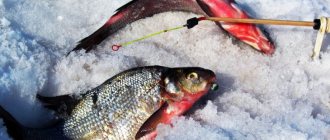Content
— What to wear for winter fishing? — What kind of fish is caught in winter? — What to fish with in winter? — What do you need for winter fishing? — How much does it cost to buy everything for winter fishing? — What does the process of winter fishing consist of? — Precautionary measures for winter fishing.
What to wear for winter fishing?
Winter fishing is exciting, but since the action takes place in winter, the weather can sometimes be harsh, be sure to pay due attention to warm clothes. If you’re warm, you’ll enjoy it, but if you’re cold, you won’t even want to think about any fishing! If you have previously encountered winter sports (skiing, snowboarding, etc.), you probably know that they use special jackets and overalls made of membrane fabric, fishing is no exception! Winter fishing suits resemble ski suits, but are designed for less activity.
So, what clothes do you need for winter fishing?
1. Thermal underwear. This is a mandatory first layer of clothing for winter sports, be it skiing, fishing, etc. The right thermal underwear replicates the functions of your skin, retains the heat generated by the body, and in case of high activity, wicks moisture to the next layer of clothing, while remaining dry. You can buy thermal underwear for fishing here.
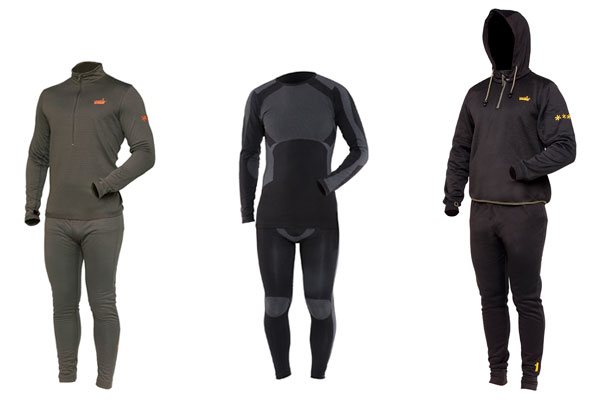
Thermal underwear options for winter fishing
2. Winter boots with isothermal liners. The expression “keep your feet warm”, familiar from childhood, comes in handy when fishing. Modern fishing boots are made of EVA material, which makes them light and comfortable. They feel like comfortable slippers. These boots are very versatile; in addition to fishing, they are convenient for walking the dog, traveling outside the city in winter, etc. You can buy winter boots here. For such boots there is no need to wear thick woolen socks; on the contrary, this can “ruin” the thermoregulation in the boots. It is better to buy special thermal socks; they are not expensive, but they perform the same functionality as thermal underwear - they remove moisture and retain heat.
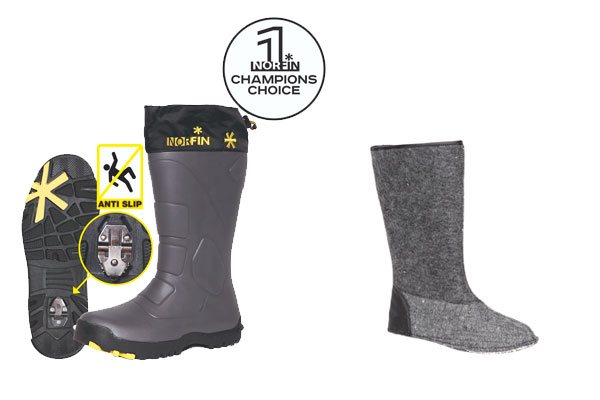
An example of Norfin Klondike winter fishing boots
3. Winter hat. It doesn’t require any additional explanation, but if you don’t have your own warm hat, you can buy a fishing hat here.
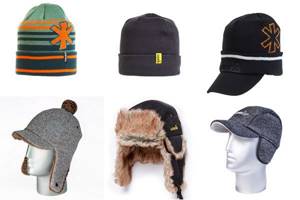
4. Mittens or gloves . There are several options here, the first is to purchase gloves or mittens, which you will have to take off when landing fish, setting bait, etc. The second option is special mitten gloves with a folding upper part; they are less warm, but more functional. You can choose mittens or gloves for winter fishing here.

5. Suit for winter fishing. It should be noted that a specialized fishing winter suit is not a cheap pleasure, so if you are sure that you do not plan to get involved in fishing in the future, you should look for alternative warm clothes in your wardrobe. But if winter fishing becomes your hobby or even more, then know that fishing in a special suit becomes much more enjoyable. One of the most popular winter clothing companies among fishermen is NORFIN (Norfin), they have both men's and women's, as well as children's models. Suits are divided into different temperature conditions, usually from -15 to -45 degrees. Fishing suits are made from a special fabric - a membrane, which differs in two main characteristics, waterproofness and breathability. You can choose and buy a winter suit here.

Winter fishing suits Norfin
Winter fishing rod with float
Unlike the flying version, it is smaller in size, since you have to fish next to the hole, and there is no need for long casts. You can catch bream, crucian carp, perch, and roach with such a fishing rod, but smaller sizes than in summer.
There are three types of float rods:
- With closed coil.
- With open coil.
- Without a reel, when the line is wound on the reel.
There are no strict rules for equipping such a fishing rod; it is similar to a summer fishing rod.
Floats for winter fishing rods
You can choose any color, size, shape of the floats to suit your taste. This does not play a fundamentally important role. The main thing is that while fishing you can see the bite.
There are four types of floats:
- Cone. The name is derived from its shape.
- Cigar. Extended float in the shape of a cigarette.
- Barrel. It is large in size with a cone-shaped top.
- Double float. From the name you can guess that these are two floats attached to each other.
Let's celebrate! In winter, when there is severe frost, so that the float does not freeze along with the hole, they try to submerge it. Even in a submerged position, the bite is still visible.
fishing line
Since the water is clearer in winter than in summer, you should try to choose a thinner line and, if possible, one that matches the color of the water. The visibility of the line can spook the fish. Don't forget about its strength.
Loading
The weight of the sinker must match the weight of the float, sometimes a little more, to sink it, as described above.
The sinker must be attached to the main line, and hooks with bait must be tied with a thinner line to the main line 5-30 cm above the load. The bait should play with the current and not lie on the ground. Therefore, you should experiment with the length of the leash.
Hooks
You can choose any hooks, the most common ones. The main thing is that they do not sink immediately, but keep them playing with the flow while fishing. Instead of hooks, you can use a jig.
There are no restrictions here. Bloodworms, maggots, black bread crust, and burdock larvae are usually used as bait. Accordingly, the size of the hook must correspond to the size of the fish we intend to catch.
What kind of fish is caught in winter?
Have you decided on your clothes, what will you catch? In order to understand what kind of fish will bite in winter, you need to understand what body of water you are going fishing on. As in summer, there are 2 main differences - catching predatory or peaceful fish.
1. On rivers, reservoirs and lakes in the central region of Russia, the main predators will be: perch, pike, pike perch, bersh, burbot. Of the white fish (peaceful fish), the catches will be dominated by: roach, bream, bream, bleak, and ruff.
2. On commercial (paid) reservoirs in winter, most often, predators such as trout, pike, and less often pike perch are caught. From white fish: whitefish and bream.
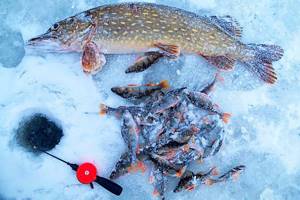
If you are invited to go fishing, try to find out as much information as possible about the place and method of fishing in order to be well prepared and fully armed.
What to fish with in winter?
When you have decided on the place and the fish that you will catch, you can start choosing gear, everything is not entirely clear here, but, in general terms, gear is divided into 2 groups: rods for predatory fish and rods for peaceful (white fish). For the first time, we recommend that you ask your friends for gear.
So, what gear is used for ice fishing?
1. A jig is a small piece of lead or tungsten with a soldered hook. Jigs are very diverse and vary in shape, color and weight. Lead jigs are lighter than tungsten ones, with the same size, so lead jigs are usually used for fishing at shallow depths. Prices for lead jigs are 2 times cheaper than for tungsten ones. The jig is tied to the end of a thin fishing line, which in turn is wound on a small fishing rod (most often the so-called “balalaika”).
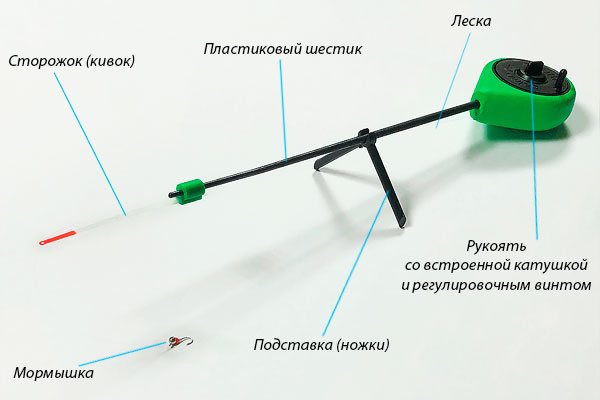
An example of equipment for a winter fishing rod - a balalaika.
Almost all white fish and perch are successfully caught using jigs. Usually, live or artificial bait is attached to the jig - bloodworms, maggots, etc. (in winter they are sold in almost any fishing store). There are also jigs that, with their shape and play, imitate various insects; they do not require an attachment; such jigs are called “reelless jigs.”
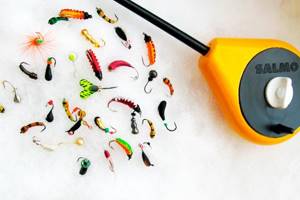
Various options for winter jigs
You can choose and buy jigs here.
The technique of fishing with a jig most often looks like this: the fisherman lowers the tackle to the bottom, which is determined by a sagging nod or guard (a thin strip of lavsan or steel, with a missing line, to determine the bite). Then he slightly lifts the tackle from the bottom and begins oscillating movements; a guard correctly selected for the jig helps to create an interesting “game” of the jig.
2. Float tackle - in almost every way the tackle is similar to a regular summer fishing rod, only on a smaller scale. There are variations when not just a hook with a sinker is placed on the bottom, but a rocker with two hooks or more. Large bloodworms are most often used as bait, and small feeding bloodworms are used to lure fish to the “point”. You can see how to make a simple winter float tackle here.
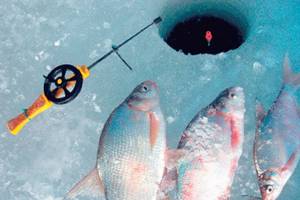
3. Balancers, amphipods, rattlins, vibes and other imitations of real fry baits - such baits are used only for catching predatory fish, they are selected for a specific fish, location and depth. For these baits, much more powerful rods are used than for float fishing or jig fishing. The rod should “pierce” the fish’s mouth when biting, and at the same time be light and sensitive. How to choose a balancer and see a selection of the most catchy balancers can be found here.
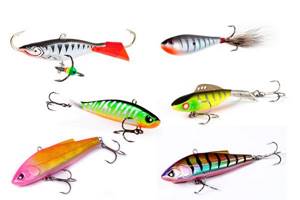
Various options for baits for predatory fish - balancers, amphipods, vibes
The sizes of baits for predators can very roughly be divided as follows:
Perch - baits ranging in size from 3 to 5 cm; Pike - from 5 to 9 cm; Pike-perch - from 6 to 9 cm; Bersh - from 4 to 6 cm; Trout - from 3 to 7 cm.
You can select and buy balancers here.
4. Spoons. Predatory fish are also caught with winter lures, as is the case with balancers; they differ in weight, color and game. You can buy winter lures for fishing here.
5. Zherlitsy. This can be said to be a passive form of catching predatory fish, but in order to drill holes and install girders, you still have to sweat. But remember that the maximum number of zherlitsa is 10 pieces per person. Most often, the bait is a “cover” for the hole, with a fixed reel and a flag that “shoots” when bitten. A fishing line is attached to the reel, with a weight and a hook at the end. For girders you need live bait - a small fish attached to a hook with a sinker. You can catch live bait yourself or buy it at a fishing store. When the girders are placed, you can catch other fish, looking to see if the flag has shot...
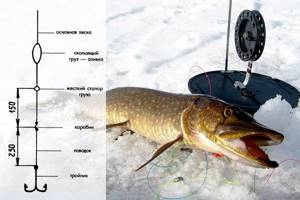
An example of equipping stationary winter gear - pike rigs
Fishing with girders requires a certain skill; you need to be able to place them around the reservoir, which implies knowledge of the water area and the behavior of the predator in a given period of winter.
Float rods
Many types of winter fishing rods are assembled on the basis of a fishing rod with legs. Winter float tackle was no exception. Here is the general principle of its construction. 1. We wind a fishing line with a diameter of 0.12-0.14 millimeters onto the reel. 2. Next, we put a float on the fishing line. 3. Below the float we distribute a load of several pellets. 4. We tie a leash made of thin fishing line, in accordance with the likely size of the trophy. When fishing, the equipment is lowered to the bottom, and the float is installed so that it is below the surface of the water. This will allow him not to freeze into the ice that covers the hole.
What else do you need for winter fishing?
So, you are dressed, you know the place where you will fish and you have selected the necessary gear, can you start fishing? Don’t rush, fishing is a delicate matter, there are still mandatory details...
Since the main action takes place on ice, it must be opened, this is done with a special device - an ice screw. The quality of the ice drill determines the time it takes to drill holes and the effort expended on it. You can drill holes manually or with an ice drill with an adapter for a screwdriver; it is much easier, but more expensive; for the first time you can definitely do it without a screwdriver. You can select and buy an ice screw here.
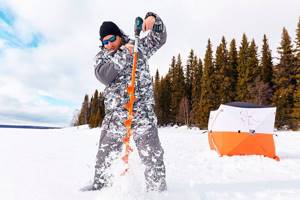
Another mandatory attribute for winter fishing is a winter box! It serves both as a place to store tackle and various fishing equipment and food supplies, and as a place to sit.
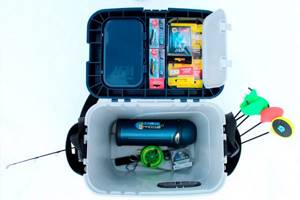
Don't forget to put a slotted spoon in the box - a scoop for removing ice from the hole. It is convenient to store bloodworms in a bloodworm container; you can buy it here. And for jigs, spinners and other baits there are special boxes and covers.
How can you take all this with you? It's all very simple - there are special fishing sleds, you load all your things into them, including an ice auger and a box, and drag them with you to the fishing spot by the rope!
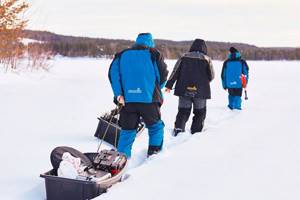
Basic inventory listed! But in fact, you can continue the list of what you might need while fishing ad infinitum, here you can find winter tents, thermoses, gas burners, echo sounders, underwater video cameras, baits and attachments, and so on, so on, so on... Try it, and after the first fishing you will understand what exactly you need in order for fishing to take place in comfort, and the catches to become more stable and larger.
Choosing an ice drill
When the ice thickness exceeds 10 centimeters, the angler will need an ice auger to actively search for fish. If the ice is quite thick, fishing without this tool becomes almost impossible. Ice screws may differ in the following characteristics:
- weight,
- height,
- screw diameter,
- knife configuration,
- manual or mechanical drilling method.
The weight of the ice auger directly depends on its height and the diameter of the auger. It is clear that the lighter the ice screw, the easier it is to work with. The height of the tool should be selected based on the individual characteristics of the fisherman and the thickness of the ice at the time of fishing. To prevent fishermen from having to buy several ice drills to suit different ice thicknesses, many manufacturers make drills with a telescopic handle, which allows you to quickly change the height of the tool. However, it is worth noting that the telescopic handle increases the weight of the drill.
The diameter of the auger is selected depending on the size and type of fish that is intended to be caught. For fishing for perch and roach, a drill with a diameter of 110 mm is quite suitable. When fishing for pike and pike perch, an ice drill with an auger diameter of 130−160 mm is used. Augers of large diameters are used when fishing for such wide-bodied fish as bream. Sports fishermen prefer to use drills of small diameters, since, as a rule, small fish are caught in competitions. In addition, drilling a hole with a small diameter ice drill is much easier.
Modern fishing drills are equipped with knives of various shapes. Rectangular and square knives work better on dry ice with a uniform structure. Rounded knives drill well into wet multi-layer ice. During fishing, knives can become dull when they come into contact with underwater snags or stones, so the fisherman should always have a spare set of knives and a tool for installing them with him.
Recently, motorized drills that run on flammable fuel have become very popular, allowing you to drill a hole even in very thick ice without much labor. Some manufacturers produce models that can be equipped with a screwdriver, which also makes drilling much easier.
It is very important to note that for safe transportation, the ice auger knives must be protected with a special cover.
How much does it cost to buy everything for winter fishing?
As you understand, winter fishing, despite its apparent simplicity, has a number of features and nuances. In order to be fully equipped, you will have to spend a considerable amount of money, however, for the first time you can save money by joining with a fishing friend who probably has an ice auger and a whole range of spare gear.

If you nevertheless decide to fully purchase gear and equipment for winter fishing, we recommend doing this consistently, in consultation with an experienced fisherman, in order to protect yourself from unnecessary and useless expenses. Your friends or managers of our stores can help you in this matter - all of them are experienced fishermen, have experience in fishing in different regions and conditions, and most importantly, are familiar with the entire range. You can get advice from our managers in one of our stores or by phone. The average cost of fishing equipment in 2019-2020 is: 1. Specialized fishing winter suit, boots, thermal underwear, mittens, hat: 14,000 - 30,000 rubles. 2. Ice screw: 2,000 – 10,000 rubles. 3. Winter box: 1,000 – 4,000 rubles. 4. Ready-made float tackle for winter fishing: 300 – 500 rubles. 5. Ready-made balalaika fishing rod for jig: 300 – 1,000 rubles. 6. Ready-made fishing rod for lures and balancers: 400 – 3,000 rubles. 7. Set of equipped girders, 10 pieces: 1,500 – 3,000 rub. 8. Skimmer, blood bottle, storage boxes: 500 – 1,000 rubles. 9. Echo sounder for winter fishing: 7,000 – 25,000 rubles. 10. Underwater video camera: 10,000 – 50,000 rubles.
As can be seen from the list presented, rods for fishing in winter are relatively inexpensive, the main part of the costs are related products that are purchased one-time and for a long time.
Comments from professionals
Nikita Dupin (ndup), director of a fishing store, sports fisherman in the jig discipline, representative of the FishingSib team:
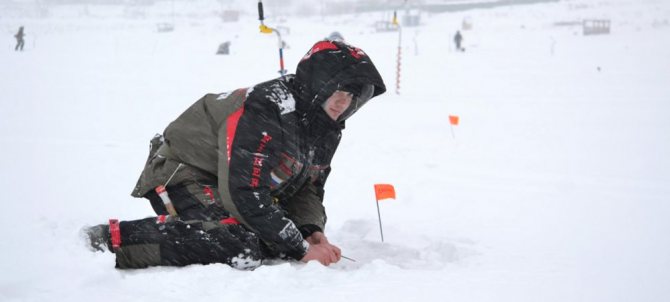
— As a representative of a fishing store, I would not advertise any specific brands. If you start preparing your set of winter clothes for fishing, I can only add that our domestic manufacturers make good winter boots. I advise you to take it to “-60 degrees”. This means that the material itself maintains this temperature, but your foot can freeze in it even at minus 20, especially when you are stationary for a long time. In general, if your feet are cold, there is only one piece of advice: take a walk, drill holes, jump on the spot, etc., etc. The average price of good boots is no less than 2000 rubles. It's the same with clothes. I advise you to take suits with a membrane of at least 7000 mm. Such suits do not allow the wind to pass through and do not get wet as quickly as regular suits. Well, it is imperative that the suit comes with overalls, then you will definitely not be blown away, and you don’t have to worry about your health.
Hats are really up to you. I fish in the most ordinary sports hat, when it’s windy I wear a balaclava. The approximate price of a hat and balaclava is 500 rubles.
It is best to take Japanese thermoses, or branded Chinese ones that cost no less than 1,000 rubles.
Fishing rods are an individual matter, and there is definitely no point in bothering novice fishermen here. We take 3-5 ordinary “balalaikas”, fishing line and jigs. You need to choose a balalaika that fits comfortably in your hand and is made of foam (your hands will not freeze). I recommend tungsten jigs, since they are heavier than lead, the fishing line should be taken only from Japanese or European material, without memory and calibrated. Price for a set of fishing rod, jig and fishing line: 2000 - 3000 thousand rubles.
In one of the videos from our official FishingSib video blog, Nikita talked about how to independently equip a fishing rod for winter fishing.
I advise you to take telescopic ice drills; they can easily adjust the drilling depth. I advise you to have a set of a 100-diameter drill and a spare 130-diameter auger. It all depends on what kind of fish you are going for. Set: 3000-3500 thousand rubles.
Finally, I want to warn novice fishermen - I do not advise going out on the ice until it reaches a thickness of 10 centimeters! It’s better to wait until he gets stronger and calmly approach him. 10 centimeters of ice can withstand any person, proven.
Nikita Larionov, a fan of winter jig fishing:
“It just so happened that my grandfather always went fishing only in winter, and did not fish at all in summer. This was probably passed on to me to some extent. Winter, frosty freshness, endless expanses of ice, you can walk as much in a day in search of fish as you usually walk in a couple of weeks. Again, it’s good for your health not to stay warm at home, but to spend time in the fresh air, hardening. And, of course, the very process of searching for fish, drilling holes, waiting for someone to bite. Although there is also interest in summer fishing, perhaps I will start fishing more actively in the summer over time. But I think ice fishing will always be my main focus.
Naturally, I'm looking forward to the opening of the season. Why? The answer, I think, is obvious, it leads there, to the endless ice expanses of the Baltic Reserve, the All-Russian Fishing Zone and smaller bodies of water.
I will never forget when I went alone for the first time on winter fishing, I didn’t have much knowledge, I collected old gear that had been passed down from my grandfather, it was some kind of Soviet drill, apparently still, with dull knives and a crooked auger. I drilled a hole for about 40 minutes, it was -20 outside (it was the beginning of January), but I was hot. Then from this hole I caught a couple of ruffs, and the most interesting thing is that they actually took the lure.
In 2015, a friend and I went somewhere in mid-November to the northern regions of our region, we went just because I wanted to travel and ride a little. I remember that there was practically no snow in the city yet, but it was already freezing. As soon as we passed the package to Bazoi, then the dirt road began, and there was already snow there, the swamps along the edges of the road were already covered in ice, we passed the Toya River, there was also ice on it, and we eventually arrived all the way to Vdovino by lunchtime. And I put a box of gear with me in the evening (just in case there were some). The Shegarka River flows in those parts, and ice has already appeared on it. We stood there, and I decided to try, I began to walk carefully on the ice, everything seemed to be fine, but suddenly I heard a little crackling, I saw the ice swaying a little, I carefully began to retreat, then jumped onto the shore, at that moment the ice cracked. As they say, it blew by, and it’s better never to take risks, but to wait a couple of weeks until the ice gets stronger.
Here are my personal tips to help answer the question of what is needed for winter fishing:
- First of all, be sure to buy thermal underwear and warm winter fishing overalls. I consider choosing a suit for ice fishing one of the most important points. Since you will have to stay in this suit for several hours in the cold or during snowfall.
- Also, don’t forget to buy warm winter boots, preferably with liners. In general, shoes for ice fishing in winter should be very warm, because your feet should always be warm.
- The minimum set, of course, includes a drill, a fisherman’s box, in which all the gear for winter fishing will be stored, and on which you can also sit while fishing.
- You can take any fishing rods for ice fishing, the main thing is that it is convenient to use them yourself, that they fit in your hand, and only the time spent on the ice will show this. For the first minimum set, we can recommend a fishing rod of the “balalaika” design, fishing line 0.1-0.12, a small set of medium-weight jigs, nods.
- I would also advise you to immediately get a sled so that you don’t have to carry all this on yourself, but calmly roll along the ice behind you.
What does the process of winter fishing consist of?
I'm ready to go fishing, what will happen there? Again, it all depends on the place and method of fishing, but the general plan looks like this:
- Arrival at the place; - Preparation of gear; - Drilling holes; - Feeding the fishing site (when catching white fish); - The fishing process; - Snack, tea; - The fishing process; - Cleaning up the area after yourself and rolling up the gear.

How about drinking? To be honest, winter fishing is not the best place to drink alcohol, but if you can’t imagine relaxing without drinking, it’s better to do it after fishing. Alcohol dilates the blood vessels, as a result of which the body begins to quickly lose heat. At first you will warm up, and then you risk quickly freezing without noticing it and getting sick. It's still better to have warm tea or coffee.
